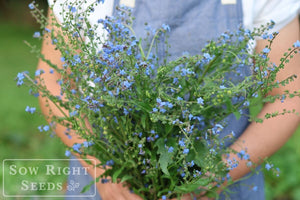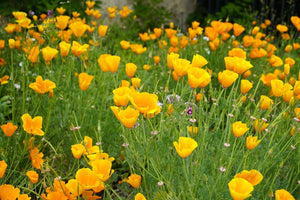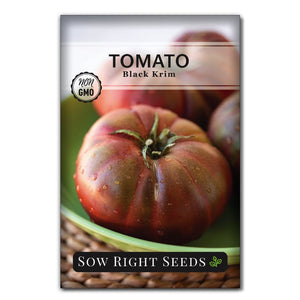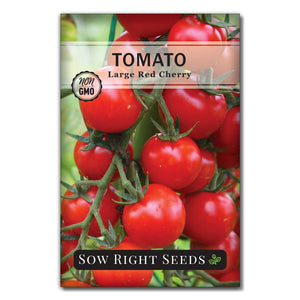5 Benefits that Will Change Your Mind About Pruning Tomatoes
TomatoesAre you hesitant about pruning your tomato plants? Not all gardeners prune their tomatoes. Some say it’s a waste of time, but others swear by it. So which option is best for you? We’ll cover the basic reasons to prune your tomato plants so you can decide what makes sense for your gardening style. The more you know, the better choices you can make for the health of your garden.

Should I Prune My Tomatoes?
If your question is, Do I have to? The answer is, No, it is not required. Healthy tomato plants that grow in full sun, fertile soil and are watered consistently will produce delicious fruit. So why do gardeners prune tomatoes?
Here are five benefits that you can reap by pruning tomato plants.
Control Growth
Pruning gives you control over where your tomato plants spread and how big they get. Indeterminate tomatoes will keep growing until growing conditions stop them. So if you don’t want your tomato plants sprawling all over, you will want to prune them back. This can be critical in greenhouses and places where space is limited. With pruning, you can also control the direction they grow on a trellis.
Better Airflow
Tomato plants can get better airflow with less foliage, especially in humid locations. Allowing airflow will reduce humidity and keep leaves dry. Airflow also contributes to better pollination of blossoms.
Bigger tomatoes
A plant with fewer branches and leaves can spend energy growing larger tomatoes. Many gardeners choose to prune tomato plants to have fewer but bigger tomatoes.
Faster Ripening
Having tomatoes ripen faster means a bigger harvest in locations with a shorter growing season. If the first fall frost is approaching, you should prune back your tomato plants so they will finish ripening before they freeze. You can do this even if you haven’t pruned your tomatoes all season.
Reduce Disease
This is the most important reason to prune tomato plants. Even if you don’t do any other pruning, at least cut back the leaves and branches that touch the ground. Several common fungal diseases are picked up through the leaves touching the soil. The most minimal but important part of pruning is to keep leaves and branches off the ground to reduce fungal diseases.

How to Prune Tomato Plants
If you’ve transplanted your tomatoes correctly, you buried the stem so deep that the first set of leaves is at soil level. This method gives your tomato plants a strong root system. But once the plant starts growing, you need to cut off these low branches.
Start with pruning from the bottom to benefit your tomato plants the most. As the plants grow, cut off leaves that touch the ground.
As the tomato plants grow, they will have a strong central stem. Off the main stem, there will be branches. There will be additional growth in the “V” between the main stem and branches. These spots of growth are what’s called a “sucker.” This sucker will then grow into a side stem producing more leaves and fruit. In greenhouse growing and when growing up a string, these suckers are pruned off to keep the plant growing up instead of out.
These suckers can be pinched off easily when they are small, under 2 inches. If they are larger than this, use sharp, clean pruners. If you want bigger, bushier plants, you can let these suckers grow.
Which parts to remove and which to keep are where gardeners can prune according to their own preferences. Once you know the reasons for pruning, you can decide how much pruning your tomato plants need.
As the tomato plant grows, you may need to cut off branches that cross over or are too unwieldy for your tomato supports.
End-of-Season Tomato Pruning
When it’s getting close to the first frost, you can top off your tomato plants. This will let the plant use its energy to finish growing and ripening the tomatoes already on the plant instead of continuing to grow leaves.
Pruning Determinate Tomatoes
Determinate tomatoes don’t need pruning other than cleaning up anything that touches the ground. Then prune up to the first leaves below the first flowers. Determinate tomatoes already have a certain size in their DNA. Cutting off branches will result in less fruit.
When should I prune tomato plants?
Start early when the suckers are small. You will need to be pruning every week or two as the plant continues to grow. Pruning when branches are small is less of a shock to the plant than cutting off large branches.
3 Pruning Tips to Avoid Disaster
1 - Use Clean Tools.
You can snap off small suckers with your fingers, but anything else should be a clean cut with sharp tools. Diseases can spread easily from plant to plant, so wipe down your tools with a disinfectant between each plant. Rubbing alcohol is inexpensive and won’t harm your shears.
2 - Prune Young Growth.
You won’t always know what branches will get out of hand, but cutting off small branches is less of a shock. Your plants won’t even notice a snip here and there. If you have to cut back larger branches, be careful not to take more than a third of the plant at a time. Also, by pruning young growth, the plant won’t spend unnecessary energy.
3 - Keep Leaves for Shade.
Even though tomato plants love full sun, the fruits themselves can get sun-scald. When pruning your plants, keep enough leaves to offer some sun protection to the tomatoes.
Now you know the benefits of pruning tomatoes! From increased yield to disease prevention, this practice can be a game-changer for any gardener.
Pruning is as hands-off or as detailed as you want it to be. It’s up to each gardener to decide what they want to do. We recommend trimming off at least the leaves and branches touching the ground. Also, remove anything that has disease.
It’s time to try pruning your tomatoes. See if it makes a difference in the size of your Mortgage Lifters or increases your Black Cherry tomato harvest.
Happy Growing!









Leave a comment